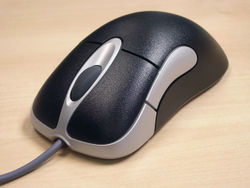Mouse button
Ever since the the introduction of the mouse, the number and function of buttons has remained system-specific.
The main function is usually on button 1 ("left mouse button"), for the index finger on the right hand. Left-handed mice tend to have the order reversed. The button order is usually also reversible in the operating system, for ambidextrous mice.
Contents
Apple

Historically, Apple Lisa and Macintosh mice had a single button. The modifier keys command and option were required in Mac OS for alternative mouse operations, such as creating an alias (shortcut) or copying a file instead of moving it. When Apple introduced context menus into Mac OS, they were opened by holding control and then clicking. A program called TheMouse2B permitted right-click context menus in classic Mac OS for two-button mice, by simulating ctrl+click; in particular, Macintosh clones with PS/2 ports would accept PC mice, and TheMouse2B supported these.
Since the introduction of Mac OS X (now macOS) USB mice have been supported, and context menus could be opened with right-click if a supporting mouse was present (initially third-party mice only).
AmigaOS
The Amiga mouse has two buttons. The left button acts as button 1 on any other system.
While the right button is pressed a menu bar appears at the top of the screen, covering the screen title (if one is present). A menu item is selected by releasing the right button when hovering the pointer above it. Releasing the mouse button elsewhere cancels. Third-party utilities were available that replaced (or complimented) the menu bar with a pop-up menu underneath the mouse pointer.
Acorn RISC OS
The Acorn Archimedes mouse had three buttons. These buttons were named Select, Menu, and Adjust[1], and functioned as follows:
- Select
- The Select button behaves the same as button 1 on any other system.
- Menu
- The centre button display a menu at the mouse cursor position. RISC OS has no menu bars, and the application menu structure appears as a context menu would on other system. If the menu was opened against an object on the screen (text selection, file icon etc) then one of the sub-menus will be for the item in question.
- Adjust
- The right button, Adjust, is the complement of the Select button. Using Adjust performs an action that is complementary to what the Select button would have provided. For example, Select-drag brings a window to the top when moving it, while Adjust-drag does not. Select-click on a Filer window's close box closes the window, while Adjust-click first opens the parent directory's window. Select-click sets the Filer (file manager) selection, while Adjust-click toggles the item within the selection. The Adjust button replaces the need to use modifier keys during mouse operation.
MS-DOS
MS-DOS had at least two competing mouse standards from Microsoft and Logitech. Microsoft-compatible mice all had two buttons. Logitech-compatible mice had three buttons. As DOS was not a graphical system, the function of the additional buttons was undefined.
Microsoft Windows

Windows currently recognises a vertical and horizontal scrolling plus five buttons: left, right, middle, back and forwards.
Microsoft formalised the convention that the second (right) button would open a context menu as of Windows 95. Prior to this point, it was an application-specific button.
Microsoft introduced the scroll wheel with Windows 98 and the Microsoft IntelliMouse. Smooth scrolling was added in Windows Vista, with a Microsoft-specific use of the HID standard.[2] The wheel can also be pressed - as the third (middle) button - a feature that remains lost on many computer users. Microsoft's IntelliMouse Optical added side buttons for Back and Forward commands, for use in Internet Explorer and Windows Explorer (File Explorer).
While the middle button had been supported and used in application programs for a long time, it was given functionality in the OS first in Windows 7: clicking the middle button on a taskbar icon (with grouping enabled) starts a new instance of the selected program, while middle-clicking one of the windows in the program's window list (Aero Basic) or thumbnail popup (Aero Glass) closes that window.
X Window System
The X Window System (X) does not itself mandate any specific policies for programs but it does have the mechanism of a "Current Selection" for which there are conventions. Text can often be selected with the left mouse pointer and then inserted at the pointer position with a simple click on the middle mouse button. Many X users prefer this method over using a (Cut, Copy, Paste) of a clipboard.
The middle mouse button is otherwise often used for scrolling, either by dragging or by emulating an analogue joystick.
The right mouse button often activates a context-sensitive pop-up menu at the pointer.
References
- ↑ Telcontar.net – The RISC OS GUI
- ↑ Microsoft - Enhanced Wheel Support in Windows. Dated 2010-11-10. Retrieved 2016-04-06